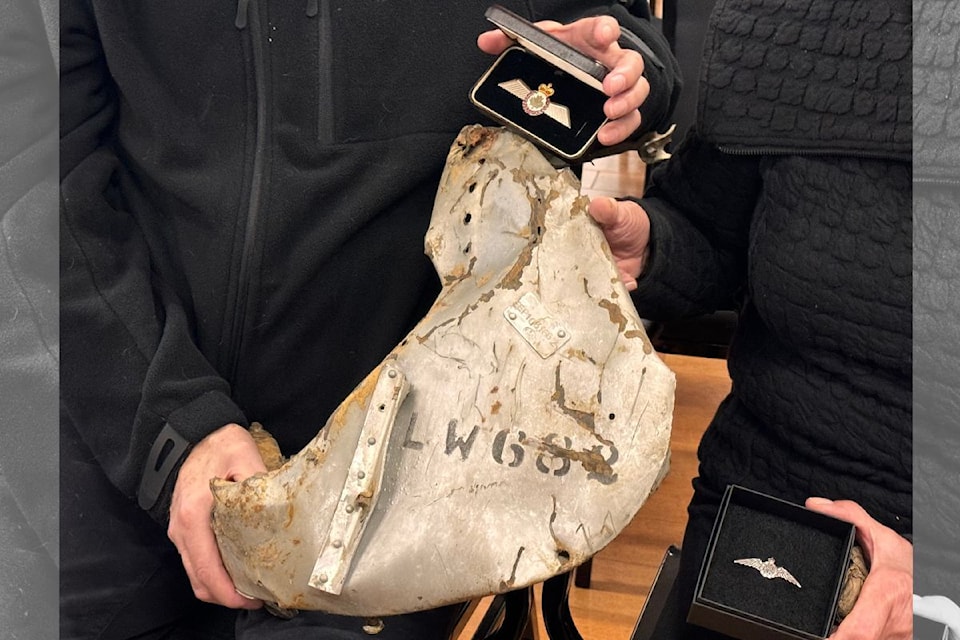"He was an ordinary guy," said Sooke's Jay Hammond, recalling the uncle he never met, Pilot Officer Wilbur Bentz (nicknamed "Wib").
Yet, the items excavated from the crash site in Belgium told a different story. Watches, a signet ring, and even a wallet, perfectly preserved in the muddy ground for over half a century, brought Wib's wartime sacrifice vividly to life.
On Friday, Oct. 18, during a ceremony at 443 Maritime Helicopter Squadron in North Saanich, Jay Hammond and his sister Maureen Thom shared the remarkable story of their uncle, a Royal Canadian Air Force pilot who died at 23 when his Halifax Bomber LW682 was shot down over Belgium on May 13, 1944.
The journey to uncover the past began in 1984, following the death of Hammond's and Thom's mother, Romaine. Wib had been her only sibling, and his loss during the Second World War haunted the family. As Hammond sifted through letters left behind, he felt compelled to learn more about his uncle's final moments. This quest eventually led him to Belgium and the bomber wreckage.
The journey came full circle in early September 1997 when Hammond, Thom, and other family members gathered at the crash site. Volunteers, armed with a heavy-duty excavator, drained the muddy site before beginning the dig. The unmistakable squeal of metal scraping metal signalled they had indeed found the bomber's remnants – clear markings on the metal confirmed the find. For three days, the excavation proceeded, reaching a depth of nine meters.
"The smell of aviation fuel permeated the work site," Hammond recalled. Among the artifacts recovered were watches frozen at the time of impact, a signet ring torn by the force of the crash, and even a silver cigarette case bearing the initials of the tail gunner.
Thom shared her own poignant memories.
"We found Jack Summerhill's wallet, completely intact, with a train ticket home from his last leave." As the volunteers dug, they uncovered partial remains of three crew members, including Wib.
The excavation stopped when the roots of a nearby poplar tree made further digging unsafe. But even though the digging ceased, the emotional unearthing for Hammond and Thom continued.
"Holding those items brought things to life," Hammond reflected. "It gave names and faces to records and letters that my mother had."
The recovery led to a full military funeral in Belgium, attended by Canadian government officials and family members. In a touching tribute, the Belgian Air Force performed a missing man formation, with one plane trailing red smoke in honour of the fallen.
Perhaps the most surprising thing to come full circle was the meeting between Hammond and Martin Drewes, the German night fighter pilot who had shot down Wib's plane. Through his research, Hammond had established contact with Drewes, and the two had corresponded for years. Drewes accepted Hammond's invitation to attend the reburial ceremony in Belgium.
"It was surreal," Thom said. "He was a gracious man, doing his job during the war. We came full circle by meeting him."
The moment helped bridge the decades, uniting former enemies in a shared act of remembrance and offering a sense of closure.
The significance of the excavation went far beyond the family's private grief. In 2012, 850 pounds of aluminum from the wreckage was donated to the Bomber Command Memorial in London. The material became part of the roof over the pavilion, symbolizing the endurance of memory. Queen Elizabeth II officially dedicated the monument, with Lancaster bombers flying overhead and thousands of poppies raining down, creating a striking image of remembrance.
Even more remarkably, since 2021, every set of Royal Canadian Air Force pilot wings contains a small amount of aluminum from Wib's plane, linking current aviators to their wartime heritage. During the Oct. 18 ceremony, Hammond was presented with a set of these special wings, along with the commander's coin and a 443 Squadron coin, recognizing his tireless efforts to preserve not only his uncle's memory but also an important piece of RCAF history.
For Hammond and Thom, born after their uncle's passing, the journey has been deeply personal.
"Our mother kept a picture of Wib on her nightstand," Thom shared. "She would look at it every night while brushing her hair. It was a very heavy loss."
As the ceremony concluded, it was clear that while Pilot Officer Wilbur Bentz may have been an "ordinary guy," his legacy is anything but. From the fragments of a crashed bomber to the wings worn by today's RCAF pilots, his story has come full circle, bridging generations and continents.
Lt.-Col. Matt Dukowski, commanding officer of 443 Maritime Helicopter Squadron, also reflected on the significance of the event.
"Remembrance Day is just around the corner, and we always talk about history. We are intrinsically tied to the people that fought. That connection is in the wings we wear every day, and we're memorializing them. I think that resonates with everyone who was in this room. Anyone who wears these wings feels that connection, understands it. I think that's very positive for our organization."
Jay Hammond, not quite ready to close the final chapter, expressed his desire to write a book about this extraordinary journey.
"That's the last thing I have to do," he said.


